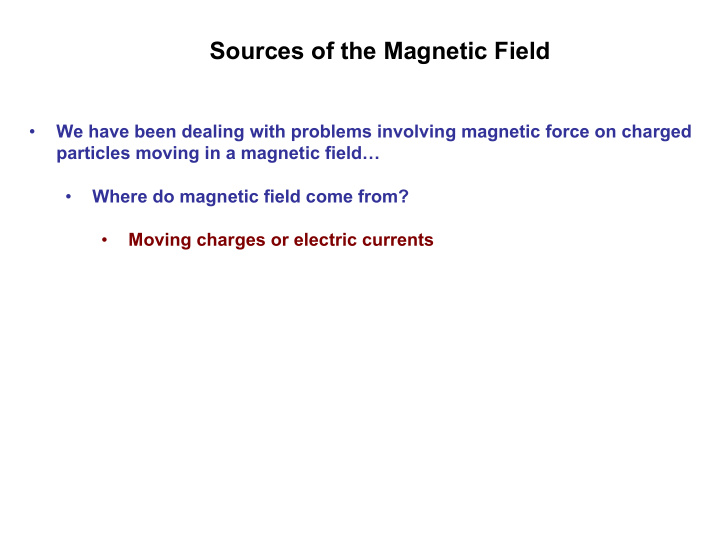



Sources of the Magnetic Field We have been dealing with problems involving magnetic force on charged • particles moving in a magnetic field… Where do magnetic field come from? • Moving charges or electric currents •
Timeline…I ~800 B.C. : The phenomenon of magnetisim was known to the early • Greeks. They discovered that certain stones (magnetite…Fe3O4) attracted pieces of iron. 1269 : Pierre de Maricourt used a spherical natural magnet to map out • the magnetic field lines using a needle placed at various points along the surface of the sphere He found that the directions formed lines that encircle the sphere • passing through two points diametrically opposite each other He called these point the poles of the magnet • 1600 : William Gilbert extended these experiments to a variety of • materials. Using the fact that a compass needle orients in preferred directions, he suggested that the Earth itself is a large permanent magnet 1750 : John Mitchell used a torsion balance to show that magnetic • poles exert attractive or repulsive forces on each other and that these forces vary as the inverse square of their separation Note: recall that although the force between two magnetic poles is • similar to the force between two electric charges there is an important difference…electric charges can be isolated
No matter how many times you cut a magnet…it will always have a North and a South Pole
William Gilbert…1600
Timeline…II • 1819: The relationship between magnetism and electricity was discovered by the Danish scientist Hans Oersted when he found that an electric current in a wire deflected a nearby compass needle • Shortly thereafter Andre Ampere obtained quantitative laws of magnetic force between current carrying conductors
• On the heels of Oersted’s discovery in 1819, Jean Babtiste Biot and Felix Savart reported on how a conductor carrying a steady current produces a force on a magnet • From their experiments results Biot and Savart were able to arrive at an expression that gives the magnetic field at some point in space in terms of the current that produces the field. • The Biot-Savart Law says that if a wire carried a steady current, I, the magnetic field dB at a point P associeated with an element ds has the following properties The magnetic field dB at a point P due to a current element ds is given by the Biot-Savart Law
Biot-Savart Law…I • The vector dB is perpendicular to bot ds (which is the dirction of the current) and to the unit vector r dircted from the element to the point P • The magnitude of dB is inversely proportional to r 2 , where r is the distance from the element to the point P • The magnitude of dB is proportional to the current and to the length ds of the element • The magnitude of dB is proportional to sin θ , where θ is the angle between the vectors ds and r
Biot-Savart Law…II The Biot-Savart Law may thus be summarized in the convenient form… where k m is a constant and is equal to…
Biot-Savart Law…III • It is once again important to note that the Biot-Savart Law as given above gives the magnetic field at a point only for a small element of the conductor. • To find the total magnetic field B at some point due to a conductor of finite size we must sum up all the contributions from all current elements making up the conductor. • In other words….we must… • Integrate Where the integral is taken over the entire conductor and must be handled with care as the integrand is a vector quantity
The Biot-Savart Law and Coulombs Law • The current element I ds produces a magnetic field • The point charge q produces an electric field • The magnitude of the magnetic field varies as the inverse square of the distance as from the current element as does the electric field due to a point charge • However…the directions are very different… • The electric field due to a point charge is radial • The magnetic field due to a current element is perpendicular to both the current element and the radius vector
1.865 • Calculate the magnitude of the magnetic field at a point 100 cm from a long, thin conductor carrying a current of 1 A
2.865 • A long, thin conductor carries a current of 10 A. At what distance from the conductor is the magnitude of the resulting magnetic field equal to 1 X 10 -4 T?
8.865 • How many turns should be in a flat circular coil of radius 0.1 meter in order for a current of 10 A to produce a magnetic field of .003 T at its center?
7.865 • A circular conductor of radius 1.2 meters carries a current of 10 amperes. What is the value of magnetic field at the center?
11.865 • A closed current path (see fig) produces a magnetic field at P, the center of the arc. If the arc subtends an angle of 30° and r is given by L / (2 + θ ) (with L=1.2 m), what are the direction and magnitude of the field produced at P if the current in the loop is 3 A.
17.866 • Two parallel conductors are each 0.5m long and carry 10A currents in opposite directions. • a) What center to center separation must the conductors have if they are to repel each other with a force of 1.0N? • b) Is this physically/practically possible?
flux
38.868 • A solenoid 2.5 cm in diameter and 30cm in length has 300 turns and carries a current of 12A. Calculate the flux through the surface of a disk of 5cm radius that is positioned perpendicular to and centered on the axis of the solenoid.
Recommend
More recommend